*This article may contain product links which pay me a small commission if you make a purchase. Learn more.
Run expectancy in baseball is simple, and incredibly important, changing how coaches think about strategy, stealing, bunting, and the value of outs and extra bases. Is bunting smart? Want to know why bunting is bad? Let’s start with a definition:
Check out My Video About Bunting & Run Expectancy
Watch my video about the value of bunting in baseball or click below:
Run expectancy: how many runs we can expect to score, on average, given a specific base/out state.
Base/out state is also simple: it’s a situation, such as runners on first and third with one out. Every hitter comes to the plate in a base/out state; it could be 2 outs and bases empty, or no one out and the bases loaded. There are 24 possible base/out states.

And, for every base/out state, there is a mountain of MLB data that shows the probability of a run scoring in that situation, and how many runs score on average in any given situation (run expectancy). We’ll touch on run expectancy and bunting today, and cover probability another day.
How Has Run Expectancy Data Changed Baseball?
Well, to be precise, it only changes baseball when players and coaches are receptive to it.
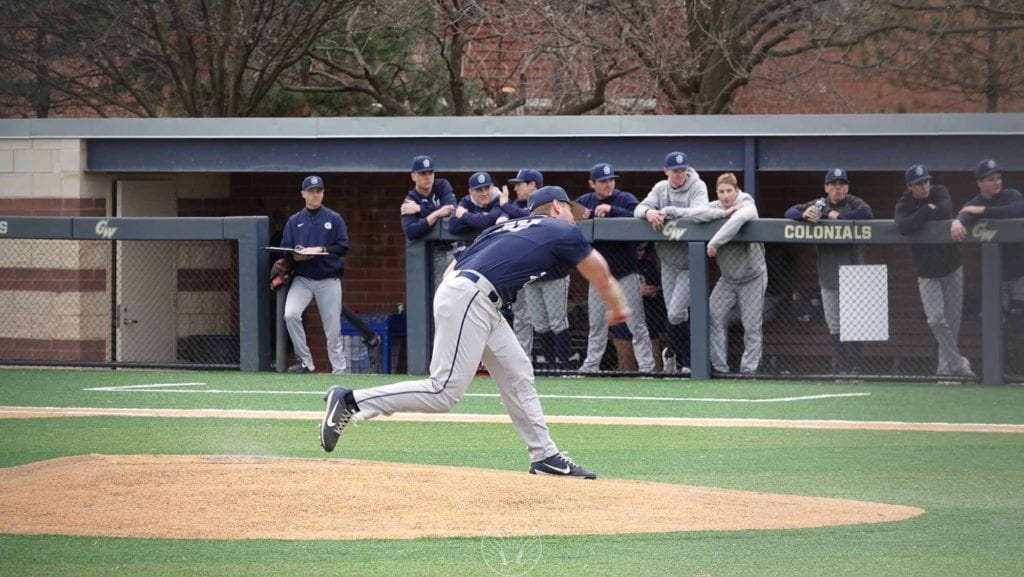
Understanding run expectancy charts helps a coach and player make good decisions based on the probability that runs will score, and how many we can typically expect.
The biggest takeaway from run expectancy is how incredibly important outs are. Every out causes a drastic reduction in expected runs, so we have to treat them like they’re precious.
This is where sacrifice bunting comes in to play…
Why Bunting Is Bad – It Can Reduce Expected Runs in Some Situations.
I’ll level with you – bunting is certainly NOT always bad.
Especially in youth baseball, where fielding even routine ground balls and bunts can be a circus, bunting can play a viable, disruptive role in the game. In the pro game, when a player bunts he is almost always out–this is a huge difference and something that needs to be taken into consideration.
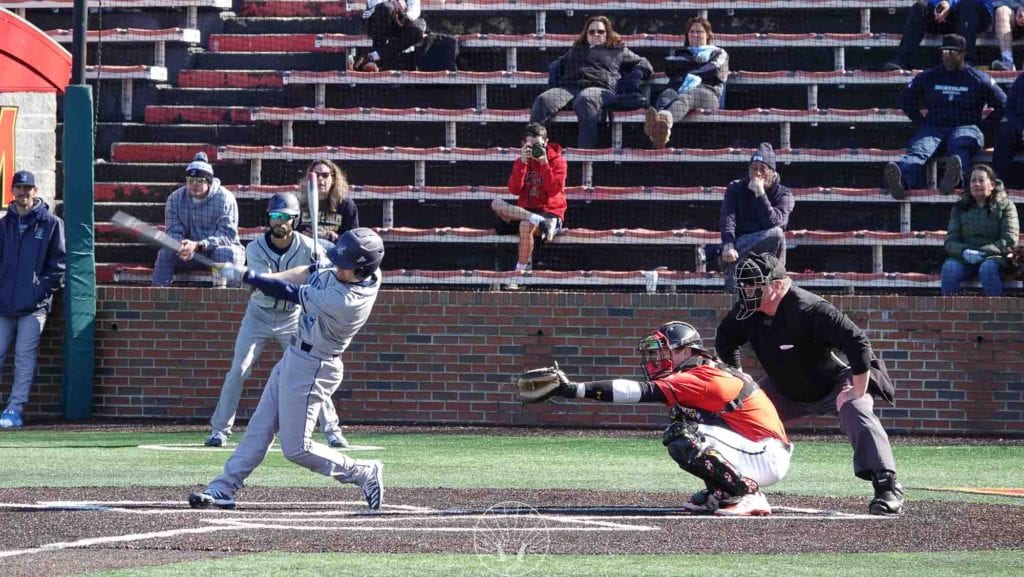
But, when we look at some of the numbers, it can definitely be a not-so-smart play in many situations.
In short, because outs are the biggest detractor from a team’s chances of scoring, sacrifice bunting hurts – a LOT. I’m not talking about bunting for hits.
Below are three charts that illustrate how expected runs decrease in the three most common bunting situations:
- Bunting a single runner from 1st to 2nd (most often used late, when the winning or tying run is aboard)
- Bunting a single runner from 2nd to third (most often used in the same situation as above)
- Bunting two runners over from 1st & 2nd, to 2nd & 3rd (this is common when weaker hitters come to bat)
I jumped onto Tom Tango’s website, Tangotiger.net, and used his run expectancy data, which I inserted into the charts below, to make the data easier for you to read. The data is from 5 MLB seasons, 2010-2015.
I recommend Mr. Tango’s book, The Book: Playing the Percentages in Baseball, which can be found Here. I really enjoyed it. The information he posts on his website is free, so please support his research.
Note: Some of the links in my posts earn me an affiliate commission. This doesn’t affect the price you pay, but I thought you should know. I only link to products or books that I’ve used, love and recommend.
Sac Bunt, 1st to 2nd
In the situation below, I’ve highlighted the two base/out states we’re dealing with: runner on 1st with no outs, which then becomes a runner on 2nd with 1 out after the bunt.
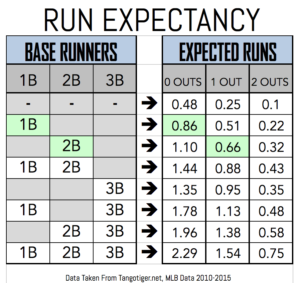
Runner on 1st, No Outs: We expect 0.86 runs on average
Runner on 2nd, One Out: We now expect only 0.66 runs on average
RESULT: The bunt reduces the success of the average inning by 0.2 runs, which means that if you bunt 10 times in this situation, your team would score 2 fewer runs than if you didn’t. This might mean two fewer games tied up or won…
Sac Bunt, 2nd to 3rd
This is a common situation, trying to move the potential tying or go-ahead run to third with one out, so that a team can “manufacture” the run. A runner on third with one out will score with a deep fly ball or ground ball to the middle infield if the infield isn’t playing in.
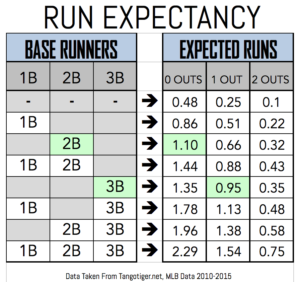
Runner on 2nd, No Outs: We expect 1.10 runs on average
Runner on 3rd, One Out: We now expect only 0.95 runs on average
RESULT: The bunt reduces the success of the average inning by 0.15 runs, which means that if you bunt 10 times in this situation, your team would score 1.5 fewer runs than if you didn’t. This seems counterintuitive, since a sac fly or middle-infield grounder can score a player from third with one out. But, nonetheless, this sac bunt hurts the inning. This reduction is smaller than in the previous, but still relevant.
Sac Bunt, 1st & 2nd to 2nd & 3rd
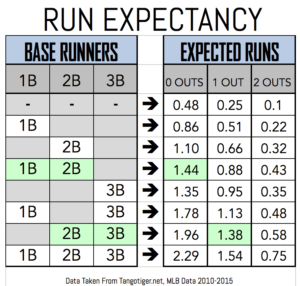
This one is probably the biggest mistake of the three in youth baseball, because it reduces the team’s chances of having a BIG inning, and big innings often single-handedly win games. The reduction in run expectancy (RE) is only 0.06 runs, and so it basically wastes an out without improving the odds of scoring.
BUT – remember, that this is MLB data below, and the effect of the double play, which will wipe out a inning faster than anything, is very real. 1st and 2nd has the double play in order, whereas 2nd and 3rd does not.
In youth baseball, especially at 16U and below, this difference is especially important, as double plays are vastly less frequent. In the Major Leagues, when the double play is in order, a double play occurs about 15% of the time.
At youth levels, this might be 5% or lower, which means that 1st and 2nd will produce even more runs than we expect in the chart to our left, since a grounder to shortstop will most likely move the situation to 1st and 3rd with one out (RE = 1.13), rather than 3rd only with 2 outs (RE = 0.35 runs).

Getting the first two runners on is the exact thing we want in producing a big inning, and giving the opposition an out hurts that goal, even more so in youth baseball than MLB baseball.
Run Expectancy Is Important!
It tells us why bunting may not be the right choice in most situations. There may be situations where a sacrifice bunt still makes sense, and bunting for hits is NOT included in this analysis of why bunting is bad. Bunting for a hit is completely different, as the goal is not to give the opposing team an out in exchange for a base.
Outs are the currency in baseball – making an out is the worst thing a hitter can do, and NOT making an out, of any kind, provides tremendous run-scoring value for a team, even just a walk, hit by pitch, or single.
Bunting FAQ
Is bunting bad?
Bunting certainly has it’s place in youth and amateur baseball, as it can be very disruptive when fielding is still not that easy of a task–players routinely make errors and struggle to make plays that college and pro players make 98% of the time. But, sacrifice bunting can reduce run expectancy, which means that trading an out for a base usually results in the statistics saying that fewer runs will be scored in that inning.
Does bunting make sense in baseball?
Yes, it still makes sense in some situations, and can be very effective in youth baseball. Bunting can often raise win expectancy in late-game situations, where moving a runner up into scoring position decreases run expectancy but increases the likelihood of getting a win where maybe that runner is the winning run. Though data has shown that bunting often reduces the chances of runs being scored in an inning, win expectancy can increase.
